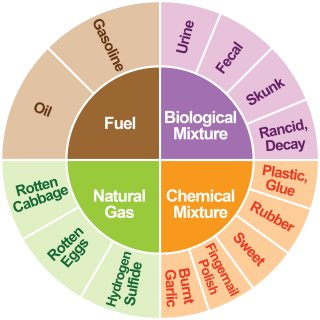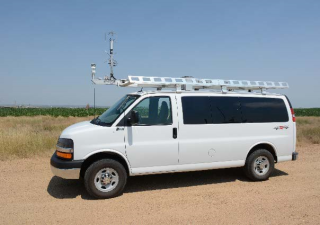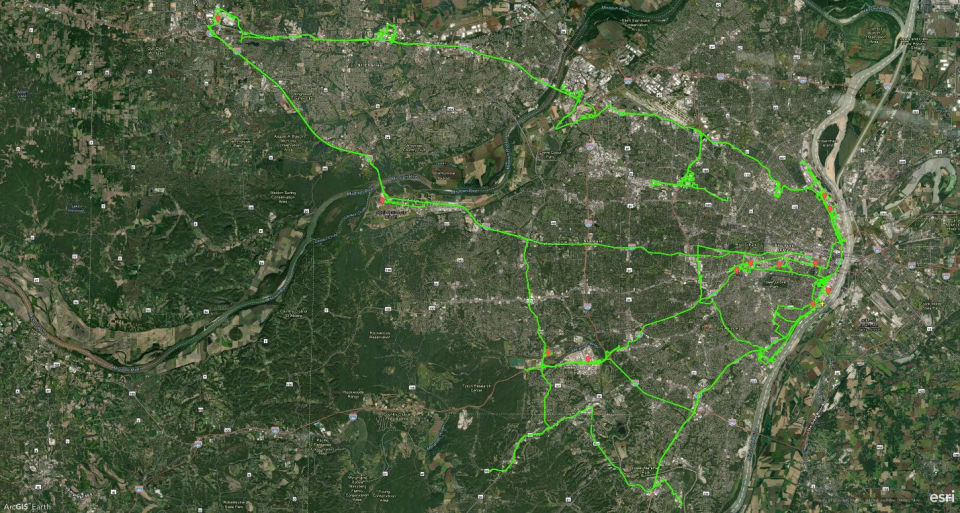Odor Concerns in St. Louis, Missouri
On this page:
- Odor Investigation
- Reporting Odor Concerns
- Clean Air Act and Odors
- Additional Information Resources
- Related Documents
Odor Investigation
Background
EPA Region 7 and the Missouri Department of Natural Resources (MoDNR) received numerous odor complaints during 2021 and 2022 from various communities in the St. Louis metropolitan area. The city also has neighborhood communities adjacent to dense concentrations of industries, and this may subject these communities to disproportionate impacts on their health and/or environment. These factors prompted EPA to further investigate the odors in the area with a mobile air monitoring vehicle (GMAP) to screen for possible emissions of regulated pollutants from facilities that may be contributing to the issues identified by the complaints.
GMAP Study
In partnership with the National Enforcement Investigation Center (NEIC), EPA Region 7 conducted a survey of several air pollutants in the St. Louis area in September 2022. EPA identified 44 facilities that reported emissions of pollutants that could be detected by the equipment in the GMAP, which was driven on the roadways and public access areas around those facilities to conduct the monitoring. In addition, stationary measurements were taken while the GMAP was parked overnight at the U.S. Army Corps of Engineers' property. The final report of the GMAP monitoring work was completed in February 2023.
Compliance Monitoring and Enforcement
Although the data collected by EPA in this project can only be used for screening purposes and does not indicate a violation of a permit, operating standard, National Ambient Air Quality Standard, or relate to a risk-based health standard, Region 7 did identify 15 facilities for follow-up compliance inspections based on the GMAP survey. In coordination with MoDNR, the on-site inspections were conducted by EPA inspectors and contract inspectors between July and September 2023. Finalized inspection reports will be available in the Related Documents section below.
EPA cannot discuss potential or ongoing enforcement actions, but information on completed actions can be found on EPA’s Enforcement and Compliance History Online website. ECHO can be used to search for specific facilities in your community, analyze compliance and enforcement trends, and find EPA cases.
EVENT |
DATE |
|---|---|
|
Odor complaints received from St. Louis citizens |
June 2021 to July 2022 |
|
GMAP survey conducted |
Sept. 12-15, 2022 |
|
Final GMAP report received from NEIC |
Feb. 22, 2023 |
|
EPA inspections conducted on selected facilities |
July to Sept. 2023 |
|
Public Meeting held on status of St. Louis odor investigation |
Oct. 25, 2023 |
|
Enforcement and compliance activities |
Ongoing |
Reporting Odor Concerns

When reporting an odor concern to EPA or the state, providing detailed descriptions of the odor and its duration, intensity, and location are key for the best possible follow-up investigations.
The “St. Louis Odor Reporting Handout” includes an odor wheel (shown at right), which can assist citizens in characterizing the smell, and guidance on all important information to provide when reporting odor concerns.
- To submit environmental concerns to MoDNR, including odors, visit their website.
- To submit environmental concerns to EPA, including odors, visit the ECHO website.
Clean Air Act and Odors
The Clean Air Act (CAA) is the federal law that regulates air emissions from stationary and mobile sources to protect human health and the environment. The CAA directs EPA to control these emissions by developing and implementing standards and guidelines. EPA currently has over 300 regulations for stationary sources that address pollutants such as nitrogen oxides, sulfur dioxide, particulate matter, volatile organic compounds (VOCs), and hazardous air pollutants. EPA does not regulate odors. Instead, EPA focusses on emissions rates as limitations.
However, MoDNR does have regulations that restrict the emissions of odors in the state. In Missouri, primary responsibility for implementation and enforcement of the CAA, which includes conducting follow-up investigations on tips and complaints, is delegated to the state and local air agencies. MoDNR’s odor rule, including compliance evaluation methods and exclusions to the rule, can be found in Missouri’s Code of State Regulations under section 10 CSR 10-165.
For additional information about MoDNR's odor rule, please visit MoDNR’s website.
Additional Information Resources
- For information on EPA’s air monitoring, enforcement, and permitting work with the Veolia ES Technical Solutions LLC facility, located in Sauget, Illinois, please visit EPA’s website.
- Summary of Clean Air Act
- Air Enforcement at EPA
- MoDNR’s Air Pollution Control Program
Related Documents
- NEIC Report - St. Louis 2022 GMAP Project (pdf) (784.8 KB)
- St. Louis Odor Complaint Investigation Presentation - October 25, 2023 (pdf) (852.96 KB)
- St. Louis Odor Reporting Handout (pdf) (41.56 KB)
| Facility | Document Type | Document Link |
|---|---|---|
| Buckeye Terminals | Final Air Inspection Report FY23 | Document (pdf) (494.91 KB) |
| Buckeye Terminals | No Further Action Letter FY24 | Document (pdf) (198.54 KB) |
| Chemisphere Corporation | Final Air Inspection Report FY23 | Document (pdf) (459.12 KB) |
| Chemisphere Corporation | No Further Action Letter FY24 | Document (pdf) (217.13 KB) |
| Elantas PDG | Final Air Inspection Report FY23 | Document (pdf) (3.73 MB) |
| Elantas PDG | No Further Action Letter FY24 | Document (pdf) (188.63 KB) |
| Elementis Specialties | Final Air Inspection Report FY23 | Document (pdf) (395.31 KB) |
| FOL Tape | Final Air Inspection Report FY23 | Document (pdf) (475.91 KB) |
| FOL Tape | No Further Action Letter FY24 | Document (pdf) (219.43 KB) |
| JD Streett | Final Air Inspection Report FY23 | Document (pdf) (517.6 KB) |
| Kinder Morgan | Final Air Inspection Report FY23 | Document (pdf) (465.24 KB) |
| Kinder Morgan | No Further Action Letter FY24 | Document (pdf) (418.36 KB) |
| Mid-West Industrial Chemical Co. | Final Air Inspection Report FY23 | Document (pdf) (333.81 KB) |
| Mid-West Industrial Chemical Co. | No Further Action Letter FY24 | Document (pdf) (202.93 KB) |
| New Frontier Materials | Final Air Inspection Report FY23 | Document (pdf) (444.92 KB) |
| New Frontier Materials | No Further Action Letter FY24 | Document (pdf) (206.33 KB) |
| PQ Corporation | Final Air Inspection Report FY23 | Document (pdf) (481.19 KB) |
| Precoat Metals | Final Air Inspection Report FY23 | Document (pdf) (632.91 KB) |
| Reichhold LLC 2 | Final Air Inspection Report FY23 | Document (pdf) (392.06 KB) |
| Superior Home Products | Final Air Inspection Report FY23 | Document (pdf) (342.46 KB) |
| Superior Home Products | No Further Action Letter FY24 | Document (pdf) (164.61 KB) |
| TransChemical | Final Air Inspection Report FY23 | Document (pdf) (318.25 KB) |
| TransChemical | Notice of Noncompliance FY24 | Document (pdf) (177.21 KB) |
| US Paint Corporation | Final Air Inspection Report FY23 | Document (pdf) (241.96 KB) |
| US Paint Corporation | Expedited Settlement Agreement FY24 | Document (pdf) (2.94 MB) |
Geospatial Measurement of Air Pollution (GMAP)

The National Enforcement Investigation Center is the environmental forensics center for EPA’s enforcement programs.
NEIC has a mobile air monitoring vehicle, called GMAP, that is equipped with analyzers for certain pollutants – methane; benzene, toluene, ethylbenzene, and xylene (BTEX); and total volatile organic compounds (VOCs) – as well as meteorological and GPS equipment. This combination of equipment allows for real-time monitoring and mapping of pollutants while the vehicle is in motion or stationary.
The GMAP’s real-time monitoring data allows EPA to screen large geographic areas for “hot spots” and helps to identify locations that need further investigation. A hot spot is an area of higher contaminant concentrations relative to other areas of a site.

